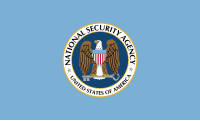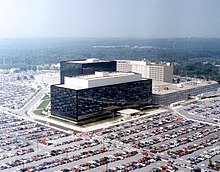 Seal of the National Security Agency | |
 Flag of the National Security Agency | |
 NSA headquarters in Fort Meade, Maryland, c. 1986 | |
| Agency overview | |
|---|---|
| Formed | November 4, 1952[1] |
| Preceding agency |
|
| Headquarters | Fort Meade, Maryland, U.S. 39°6′32″N 76°46′17″W / 39.10889°N 76.77139°W |
| Motto | "Defending Our Nation. Securing the Future." |
| Employees | Classified (est. 30,000–40,000)[2][3][4][5] |
| Annual budget | Classified (estimated $10.8 billion, 2013)[6][7] |
| Agency executives |
|
| Parent agency | Department of Defense |
| Website | nsa.gov |
 National Security Agency surveillance |
|---|
 |
| United States Armed Forces |
|---|
 |
| Executive departments |
| Staff |
| Military departments |
| Military services |
| Command structure |
| Combat Response Agencies |
The National Security Agency (NSA) is an intelligence agency of the United States Department of Defense, under the authority of the Director of National Intelligence (DNI). The NSA is responsible for global monitoring, collection, and processing of information and data for foreign intelligence and counterintelligence purposes, specializing in a discipline known as signals intelligence (SIGINT). The NSA is also tasked with the protection of U.S. communications networks and information systems.[8][9] The NSA relies on a variety of measures to accomplish its mission, the majority of which are clandestine.[10] The NSA has roughly 32,000 employees.[11]
Originating as a unit to decipher coded communications in World War II, it was officially formed as the NSA by President Harry S. Truman in 1952. Between then and the end of the Cold War, it became the largest of the U.S. intelligence organizations in terms of personnel and budget, but information available as of 2013 indicates that the Central Intelligence Agency (CIA) pulled ahead in this regard, with a budget of $14.7 billion.[6][12] The NSA currently conducts worldwide mass data collection and has been known to physically bug electronic systems as one method to this end.[13] The NSA is also alleged to have been behind such attack software as Stuxnet, which severely damaged Iran's nuclear program.[14][15] The NSA, alongside the CIA, maintains a physical presence in many countries across the globe; the CIA/NSA joint Special Collection Service (a highly classified intelligence team) inserts eavesdropping devices in high-value targets (such as presidential palaces or embassies). SCS collection tactics allegedly encompass "close surveillance, burglary, wiretapping, [and] breaking and entering".[16]
Unlike the CIA and the Defense Intelligence Agency (DIA), both of which specialize primarily in foreign human espionage, the NSA does not publicly conduct human intelligence gathering. The NSA is entrusted with assisting with and coordinating, SIGINT elements for other government organizations—which are prevented by Executive Order from engaging in such activities on their own.[17] As part of these responsibilities, the agency has a co-located organization called the Central Security Service (CSS), which facilitates cooperation between the NSA and other U.S. defense cryptanalysis components. To further ensure streamlined communication between the signals intelligence community divisions, the NSA Director simultaneously serves as the Commander of the United States Cyber Command and as Chief of the Central Security Service.
The NSA's actions have been a matter of political controversy on several occasions, including its spying on anti–Vietnam War leaders and the agency's participation in economic espionage. In 2013, the NSA had many of its secret surveillance programs revealed to the public by Edward Snowden, a former NSA contractor. According to the leaked documents, the NSA intercepts and stores the communications of over a billion people worldwide, including United States citizens. The documents also revealed that the NSA tracks hundreds of millions of people's movements using cell phones metadata. Internationally, research has pointed to the NSA's ability to surveil the domestic Internet traffic of foreign countries through "boomerang routing".[18]
- ^ Burns, Thomas L. (1990). "The Origins of the National Security Agency" (PDF). United States Cryptologic History. National Security Agency. p. 97. Archived from the original (PDF) on March 22, 2016. Retrieved August 23, 2016.
- ^ "60 Years of Defending Our Nation" (PDF). National Security Agency. 2012. p. 3. Archived from the original (PDF) on 2013-06-14. Retrieved July 6, 2013.
On November 4, 2012, the National Security Agency (NSA) celebrates its 60th anniversary of providing critical information to U.S. decision makers and Armed Forces personnel in defense of our Nation. NSA has evolved from a staff of approximately 7,600 military and civilian employees housed in 1952 in a vacated school in Arlington, VA, into a workforce of more than 30,000 demographically diverse men and women located at NSA headquarters in Ft. Meade, MD, in four national Cryptologic Centers, and at sites throughout the world.
- ^ Priest, Dana (July 21, 2013). "NSA growth fueled by the need to target terrorists". The Washington Post. Archived from the original on February 16, 2014. Retrieved July 22, 2013.
Since the attacks of Sept. 11, 2001, its civilian and military workforce has grown by one-third, to about 33,000, according to the NSA. Its budget has roughly doubled.
- ^ Cite error: The named reference
Introvwas invoked but never defined (see the help page). - ^ Cite error: The named reference
employeeswas invoked but never defined (see the help page). - ^ a b Gellman, Barton; Greg Miller (August 29, 2013). "U.S. spy network's successes, failures and objectives detailed in 'black budget' summary". The Washington Post. p. 3. Archived from the original on September 1, 2013. Retrieved August 29, 2013.
- ^ Shane, Scott (August 29, 2013). "New Leaked Document Outlines U.S. Spending on Intelligence Agencies". The New York Times. Archived from the original on August 30, 2013. Retrieved August 29, 2013.
- ^ "About NSA: Mission". National Security Agency. Archived from the original on September 18, 2014. Retrieved September 14, 2014.
- ^ Cite error: The named reference
Nakashimawas invoked but never defined (see the help page). - ^ Executive Order 13470 – 2008 Amendments to Executive Order 12333 Archived 2018-11-13 at the Wayback Machine, United States Intelligence Activities, July 30, 2008 (PDF)
- ^ Schorr, Daniel (January 29, 2006). "A Brief History of the NSA". NPR. Archived from the original on September 15, 2021. Retrieved September 15, 2021.
- ^ Bamford, James. Body of Secrets: Anatomy of the Ultra-Secret National Security Agency, Random House Digital, Inc., December 18, 2007
- ^ Malkin, Bonnie. "NSA surveillance: US bugged EU offices". The Daily Telegraph, June 30, 2013.
- ^ Ngak, Chenda. "NSA leaker Snowden claimed U.S. and Israel co-wrote Stuxnet virus" Archived 2024-05-12 at the Wayback Machine, CBS, July 9, 2013
- ^ Bamford, James (June 12, 2013). "The Secret War". Wired. Archived from the original on January 25, 2014.
- ^ Lichtblau, Eric (February 28, 2001). "Spy Suspect May Have Revealed U.S. Bugging; Espionage: Hanssen left signs that he told Russia where top-secret overseas eavesdropping devices are placed, officials say". Los Angeles Times. p. A1. Archived from the original on April 17, 2001. Retrieved April 1, 2015.
- ^ Executive Order 13470 – 2008 Amendments to Executive Order 12333 Archived 2018-11-13 at the Wayback Machine, United States Intelligence Activities, Section C.2, July 30, 2008
- ^ Obar, Jonathan A.; Clement, Andrew (July 1, 2013) [June 5–7, 2012]. Ross, P.; Shtern, J. (eds.). Internet Surveillance and Boomerang Routing: A Call for Canadian Network Sovereignty. TEM 2013: Proceedings of the Technology & Emerging Media Track – Annual Conference of the Canadian Communication Association. Victoria, British Columbia. doi:10.2139/ssrn.2311792. SSRN 2311792.